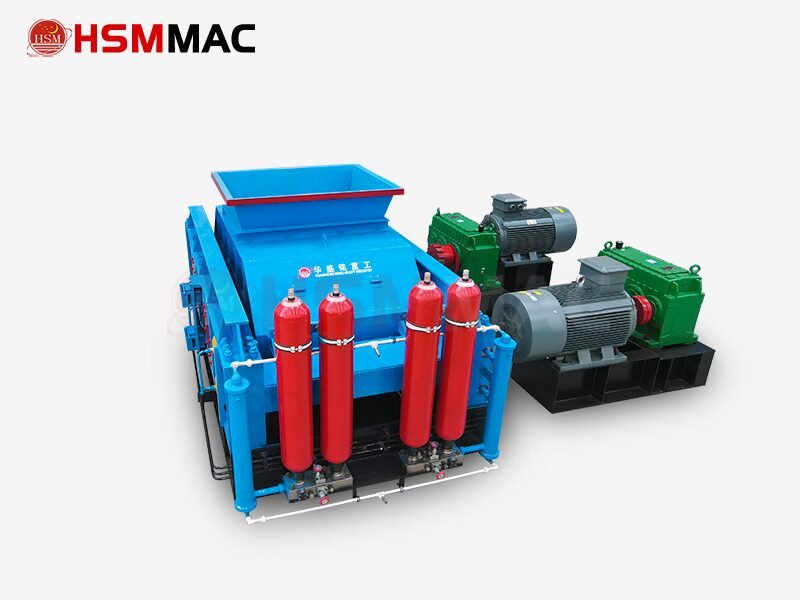Huashengming Gold Rock Crusher (primarily a roller crusher) operates on the principle of dual-roller compression crushing combined with shear tensile action. Hydraulic or mechanical adjustment precisely controls the discharge particle size (1-50mm), making it particularly suitable for crushing high-hardness or high-moisture sticky materials such as muddy gold ore and granite.

Gold Rock Crusher
1. Core Crushing Principle
Synergistic Action of Compression and Shearing
Upon entering the gap between the two rollers, the material undergoes dual forces: high-pressure compression and serrated shearing:
Compression Crushing: The two rollers rotate in opposite directions (with a designed speed differential), applying sustained high pressure to the material, causing the rock to fracture along its weak joints.
Shear Tension: The serrated roller surfaces (e.g., wolf teeth, wave teeth) enhance shear forces on the material. This is particularly effective for sticky particles in muddy gold ore, where tension strips away the clay layers enveloping gold grains.
This synergistic action significantly reduces over-crushing rates (<10%) and improves gold ore leaching efficiency.
Simultaneous Particle Size Classification
Certain models (e.g., high-efficiency classification crushers) incorporate direct screening through inter-tooth gaps during crushing. Qualified particles are rapidly discharged, while oversized particles are returned for re-crushing, preventing pulverization from repeated crushing.
2. Particle Size Control Mechanisms
Hydraulic/Spring Adjustment System
Adjustment Method: Dynamically adjusts roller gap (0-50mm range) via hydraulic cylinders or spring mechanisms with ±0.1mm precision.
Particle Size Control:
Narrowing gap → Finer output size (e.g., 1-3mm fine sand)
Widening gap → Coarser output size (e.g., 40mm aggregate)
Hydraulic models support AI real-time monitoring of material properties, automatically optimizing roll gap parameters to ensure over 95% of finished products meet target particle size.
Wedge/Shim-Assisted Adjustment
Some lower-spec models use mechanical adjustment:
Wedge mechanism: Bolt-controlled wedge block elevation indirectly alters roll distance;
Shim mechanism: Adjust gap by adding/removing shims or altering their thickness.
3. Wear Resistance & Protection System
Three-Layer Composite Roll Shell Technology
Structural Design: Outer layer of high-chromium alloy (hardness HRC60+) + middle layer of high-manganese steel + bottom layer with dovetail groove locking substrate;
Lifespan Advantages: Wear resistance 3 times higher than standard steel, processing capacity exceeding 30,000 tons, lifespan >2 years (in high-abrasion environments like gold mines).
Overload Protection Mechanism
Hydraulic Automatic Retreat: Upon encountering rebar or non-crushable objects, the hydraulic system instantly releases pressure, causing the rollers to automatically separate and evade;
Mechanical Safety Device: The jaw crusher’s toggle plate design fractures during overload, protecting core components.
4. Wet Material Adaptability Design
Screenless Anti-Blocking Structure
The dual-tooth roller model eliminates traditional screens. Spiral-arranged tooth rollers enhance wet material grip, enabling direct crushing of clay-rich gold ore with moisture content ≤15% and near-zero blockage.
Scraper Self-Cleaning System
Alloy scrapers mounted on roller surfaces continuously remove adhering clay, preventing “roller wrapping.”
5. Intelligent Control System (High-Spec Models)
AI Dynamic Adjustment
Real-time monitoring of material hardness, moisture content, and feed rate enables automatic adjustment of roll gap, rotational speed, and motor power, reducing energy consumption by 25%.
Remote Monitoring and Early Warning
Supports mobile device-based start/stop operations and parameter adjustments;
Fault early warning (e.g., 72-hour advance alerts for abnormal bearing temperature rise).



